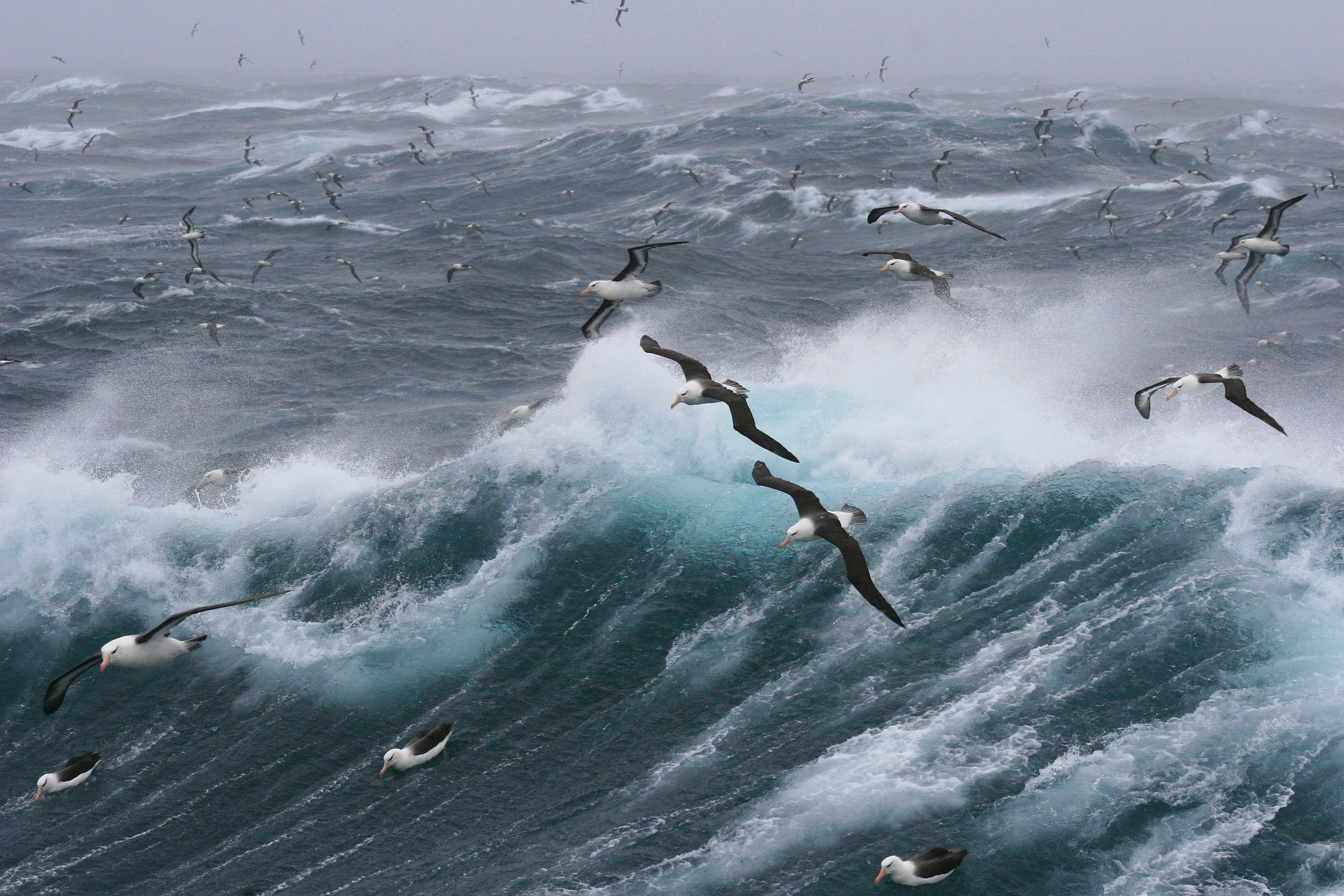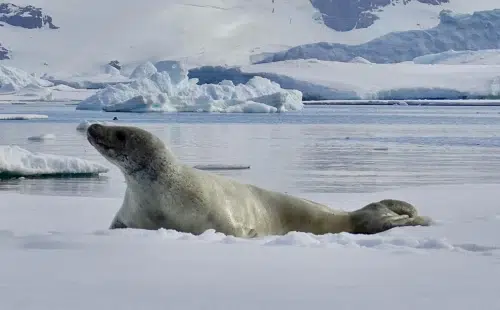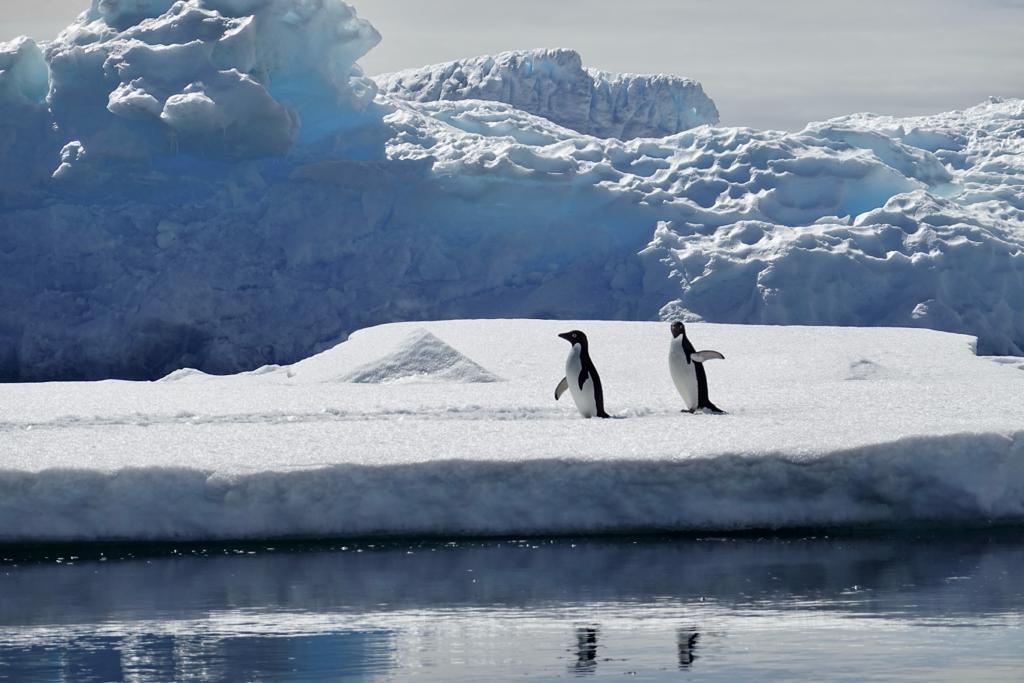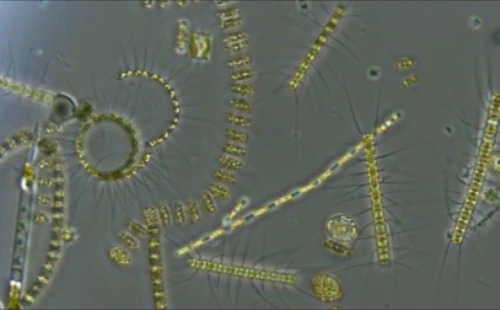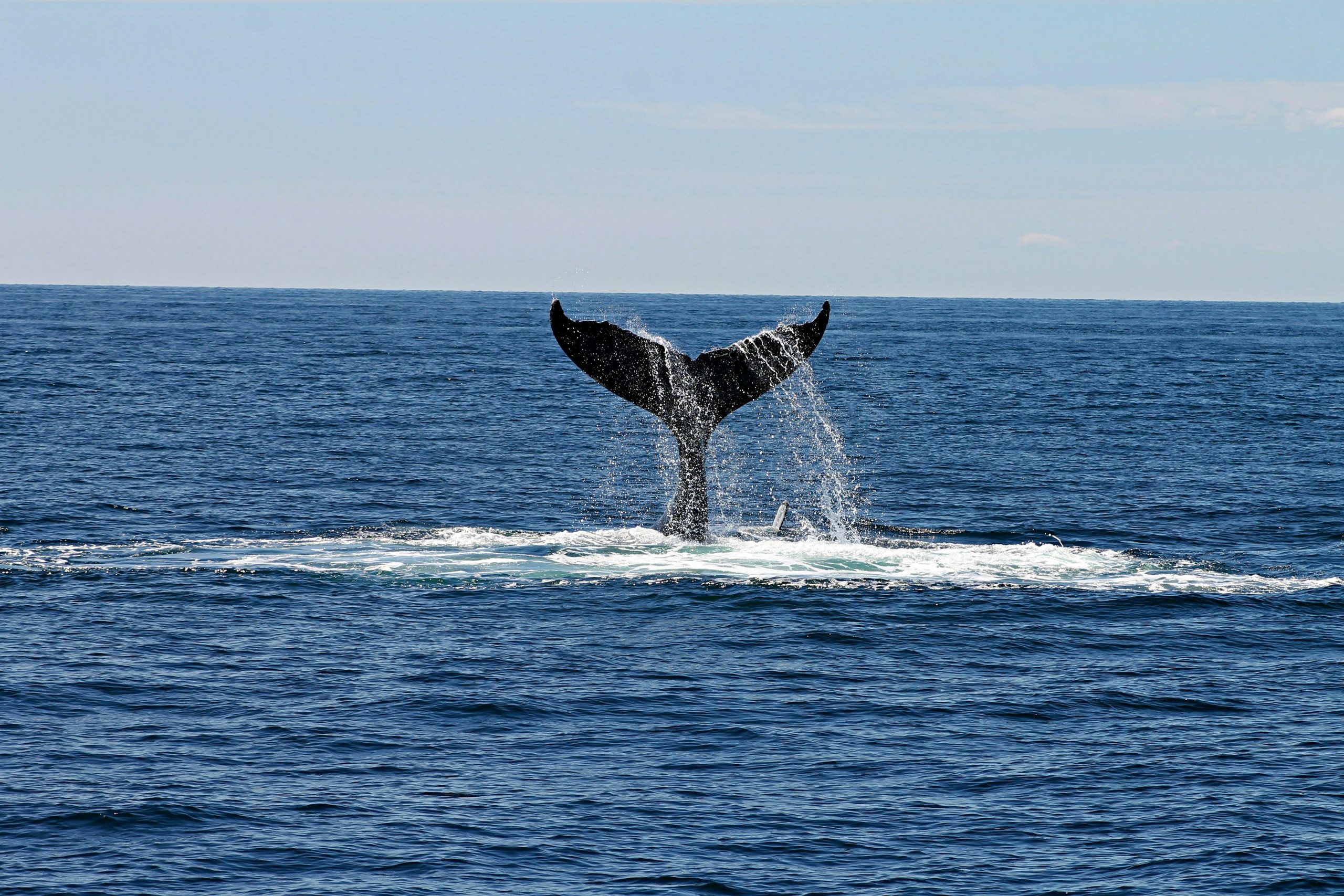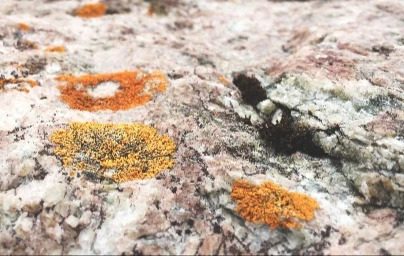Penguins of Antarctica
Penguins are a fascinating group of flightless birds uniquely adapted to life in the Southern Hemisphere’s cold and often harsh environments. Known for their striking black-and-white colouring and exceptional swimming abilities, penguins are specially adapted to thrive in marine ecosystems, relying on streamlined bodies and powerful flippers for efficient underwater hunting.
Found primarily in Antarctica and surrounding regions, penguins have evolved diverse behaviours and adaptations to survive extreme conditions, from icy coasts to temperate island shores. Their complex social structures, breeding habits, and remarkable resilience have made them an iconic symbol of the polar regions, sparking global interest and conservation efforts to protect these remarkable birds and their habitats.
Click the Links To Jump to Each Species:
Life in the Freezer
Penguins have evolved several remarkable adaptations that allow them to survive and thrive in cold climates, particularly in Antarctic and sub-Antarctic regions. These adaptations involve physical features, behaviours, and physiological mechanisms that help them conserve heat, find food, and reproduce in extreme conditions.
Insulating Feathers and Blubber
Penguins have dense, waterproof feathers that trap a layer of air close to their bodies, providing a critical barrier against the cold. Beneath this layer, they also possess a thick layer of blubber, which serves as insulation and an energy reserve during long periods at sea or when food is scarce. This combination of feathers and blubber keeps them warm and buoyant, aiding in efficient swimming and diving.
Efficient Heat Conservation
Penguins have a counter-current heat exchange system in their flippers and legs that minimizes heat loss. This system directs blood flow through closely aligned arteries and veins, allowing heat from warm arterial blood to transfer to the returning venous blood. This process maintains a warm core temperature while limiting heat loss in their extremities, which are often in direct contact with icy surfaces or cold water.
Behavioural Adaptations
Penguins exhibit several behaviours that help them endure cold climates. In extreme conditions, many species form large huddles, pressing their bodies together to share warmth and reduce exposure to cold winds. Emperor penguins, for example, famously huddle in massive groups during the Antarctic winter, taking turns being on the outer edges of the group to minimize individual heat loss. Penguins also limit their exposure to the cold by spending long periods foraging in the relatively warmer ocean.
Streamlined Body and Flippers for Efficient Swimming
While swimming might expose them to cold water, penguins are incredibly efficient in the water due to their streamlined bodies and strong flippers. This body shape minimizes heat loss by allowing them to hunt quickly and efficiently, reducing the amount of time they spend in open water. Additionally, their fast swimming speed helps them avoid predators and access rich feeding grounds, providing the energy reserves they need to maintain body heat.
These combined adaptations make penguins highly specialized for cold environments, allowing them to survive where few other animals can. Each adaptation contributes to their ability to thrive in some of the harshest climates on Earth, highlighting the unique evolutionary path penguins have taken to become masters of the polar seas.
Impact of Climate Change on Antarctic Penguin Populations
Climate change poses severe risks to penguins of Antarctica, particularly by disrupting their breeding habitats. Warmer temperatures and changing ice conditions force these penguins to compete more intensely for resources. This shift is especially detrimental for Adélie and emperor penguins, who rely on stable sea ice for successful breeding.
As the Antarctic environment warms, some penguin populations are migrating to new areas to find suitable conditions. Others, however, are forced to adapt to less optimal habitats, leading to potential declines in survival rates. These environmental changes place additional stress on penguins, endangering their long-term viability and affecting Antarctic biodiversity.
Gentoo Penguin (Pygoscelis papua)
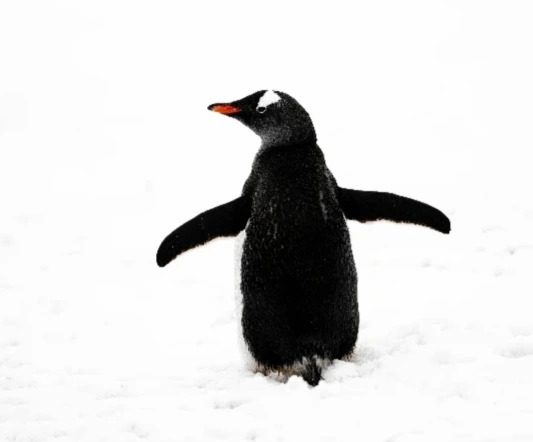
Gentoo penguins, with their striking white eye patches and vibrant orange bills, are among the most distinctive residents of the Antarctic region. Known for their playful behaviour, strong swimming skills, and vocal courtship rituals, these birds have adapted impressively to life in the extreme environment of the southern continent.
As the most northerly of the Antarctic penguins, gentoo penguins offer unique insights into the health of the marine ecosystem, drawing the attention of scientists and visitors alike.
Appearance
Gentoo penguins are immediately recognisable by their bright orange-red bills and the prominent white patches above their eyes, standing out against their sleek black heads. These penguins, reaching up to 90 cm (35 inches) in height, are the third-largest penguin species, with an average weight of 5–8 kg.
Unlike other penguins, gentoos have longer tails, which flick back and forth as they walk, adding to their distinctive appearance.
Their physical adaptations, such as a streamlined body and powerful flippers, allow them to thrive in Antarctic waters, making them adept swimmers in one of the world’s harshest climates.
Behaviour
Highly social and curious, gentoo penguins exhibit behaviours that intrigue researchers and onlookers alike. These penguins are exceptionally agile swimmers, reaching speeds of up to 36 km/h (22.4 mph) underwater. Their natural curiosity often leads them to approach humans without hesitation, a trait that highlights their adaptability to both their environment and human presence.
During the breeding season, gentoo penguins engage in loud and elaborate courtship displays, transforming colonies into bustling centres of activity. Their sociable nature and animated interactions make them a focus for scientists studying the behavioural ecology of penguins in Antarctica.
Diet
The diet of gentoo penguins primarily consists of krill, supplemented by fish and squid. These penguins are capable of diving to depths exceeding 200 meters (656 feet) to capture prey, though they usually forage in shallower waters where food is more accessible. Their dietary habits, along with their position in the food chain, provide researchers with important data on Antarctic marine ecosystems.
Due to their deep-diving abilities and varied diet, gentoo penguins serve as indicators of ecosystem health, reflecting changes in prey availability linked to environmental factors, including climate change.
Reproductive Cycle
Gentoo penguins display strong site fidelity, returning to the same breeding grounds each year to nest. They construct circular nests from stones, grass, and moss and remain monogamous within a breeding season, with both parents sharing responsibilities for incubation and chick-rearing.
Throughout the breeding season, colonies become lively as penguins interact, defend nesting sites, and care for their young. This period highlights the collaborative and resilient nature of gentoo penguins, underscoring their role as active members of the Antarctic ecosystem.
Habitat
While gentoo penguins inhabit many sub-Antarctic islands, their populations on the Antarctic Peninsula are particularly notable due to the rapid environmental changes in this region. They prefer nesting sites close to coastal areas, often establishing colonies on beaches or low slopes near the water.
The presence of gentoo penguins in these areas enables scientists to track how habitat shifts affect Antarctic species. As warming temperatures influence sea ice and food availability, studying gentoo populations helps assess the broader impacts of climate change on Antarctic biodiversity.
Ecological Role
The study and conservation of gentoo penguins are essential for understanding the effects of climate change on Antarctic ecosystems. These charismatic birds contribute to biodiversity and act as bioindicators of ocean health, reflecting the impacts of environmental shifts on marine life in the Southern Ocean.
As we continue to monitor the Antarctic region, the resilience and adaptability of the gentoo penguins of Antarctica remind us of the intricate balance required to sustain life in extreme environments. Protecting these penguins is vital for preserving the delicate ecosystems they inhabit and for gaining insights into how Antarctic wildlife is adapting to an evolving climate.
Through their survival, gentoo penguins stand as symbols of adaptation in one of Earth’s most unforgiving landscapes.
Back To Top
Adélie Penguin (Pygoscelis adeliae)
The Adélie penguin, with its classic tuxedo appearance and distinctive white eye rings, stands as an icon of Antarctica’s icy wilderness. Known for their resilience and adaptability, Adélies are true Antarctic residents, spending their entire lives on the continent and in its frigid surrounding waters.
These penguins provide essential insights into the health of the Antarctic ecosystem, making them key indicators of ecological changes influenced by climate change. Studying Adélie penguins enhances our understanding of polar biodiversity and sheds light on the impacts of global environmental changes on specialised Antarctic species.
Appearance
Adélie penguins are medium-sized, typically standing around 70 cm (28 inches) tall and weighing up to 6 kg (13 lbs). Their distinctive look, with black backs, white fronts, and the characteristic white ring around each eye, gives them a quintessential penguin appearance. Their black-tipped, orange bills add to their recognisable profile, contributing to their popularity as symbols of Antarctica.
These penguins’ compact and robust build, combined with their short wings adapted as flippers, enables them to navigate both land and sea efficiently, which is crucial for their survival in extreme conditions.
Behaviour
Adélie penguins are highly social birds, exhibiting intricate social behaviours, especially during the breeding season. They are adept swimmers, relying on their speed and agility to evade predators and capture prey. On land, they are known for their waddling gait and a unique behaviour called “tobogganing,” where they slide across the ice on their bellies, using their flippers for propulsion.
During breeding, Adélie penguin colonies become bustling centres of activity, filled with the sights and sounds of courtship, nesting, and chick-rearing. Their lively social interactions and strong bonds with their mates reflect their highly structured and resilient social structure.
Diet
The diet of Adélie penguins consists mainly of krill, supplemented by small fish and squid. These penguins are skilled divers, capable of reaching depths over 175 meters (574 feet), though they typically hunt in shallower waters where prey is more accessible. Their foraging trips can extend hundreds of kilometres from their breeding sites, particularly during the non-breeding season when they seek out abundant feeding grounds.
Their position in the food chain makes Adélie penguins important indicators of Antarctic marine ecosystem health. Any shifts in prey availability, often linked to climate-driven changes in sea ice, directly impact their populations and provide valuable data on ecosystem stability.
Reproductive Cycle
Adélie penguins breed on the rocky, ice-free shores of Antarctica. Known for their loyalty, they return to the same nesting sites and reunite with the same mates each year. The breeding season begins in October, as the sea ice recedes, allowing pairs to gather at established nesting grounds. Adélie penguins typically lay two eggs, and both parents share incubation duties, later feeding their chicks with regurgitated krill and fish.
The highly coordinated reproductive cycle of Adélie penguins ensures their chicks are born during times of optimal food availability. This cyclical return to established breeding sites demonstrates their strong connection to specific habitats, which makes them particularly vulnerable to environmental changes.
Habitat
Exclusively found in Antarctica, Adélie penguins inhabit coastal regions and nearby islands, making them one of the southernmost breeding birds globally. Some colonies are located only a few hundred kilometres from the South Pole. Their preference for breeding on ice-free land makes them sensitive to shifts in sea ice conditions, a critical factor in climate change studies.
The geographic range and habitat preferences of Adélie penguins enable scientists to monitor how climate-driven changes affect Antarctic wildlife. As warming temperatures and shifting ice patterns alter their environment, Adélie penguins’ responses provide critical insights into the broader implications of climate change.
Ecological Role
The life of Adélie penguins in Antarctica illustrates a powerful story of adaptation and survival in one of Earth’s harshest climates. Their populations reflect the health of the Antarctic ecosystem, serving as indicators of changes within their dynamic, icy habitat. As “ambassadors” of the Antarctic, these penguins highlight the need for conservation efforts to protect the unique biodiversity of this remote continent.
The Adélie penguin’s existence underscores the importance of environmental stewardship, as the global impacts of climate change threaten not only these remarkable birds but the fragile ecosystems they inhabit. Protecting Adélie penguins is essential for preserving Antarctic biodiversity and understanding the far-reaching consequences of environmental change on polar species.
Through their resilience, these penguins remind us of the intricate balance required to sustain life in extreme environments.
Back To Top
Chinstrap Penguin (Pygoscelis antarcticus)
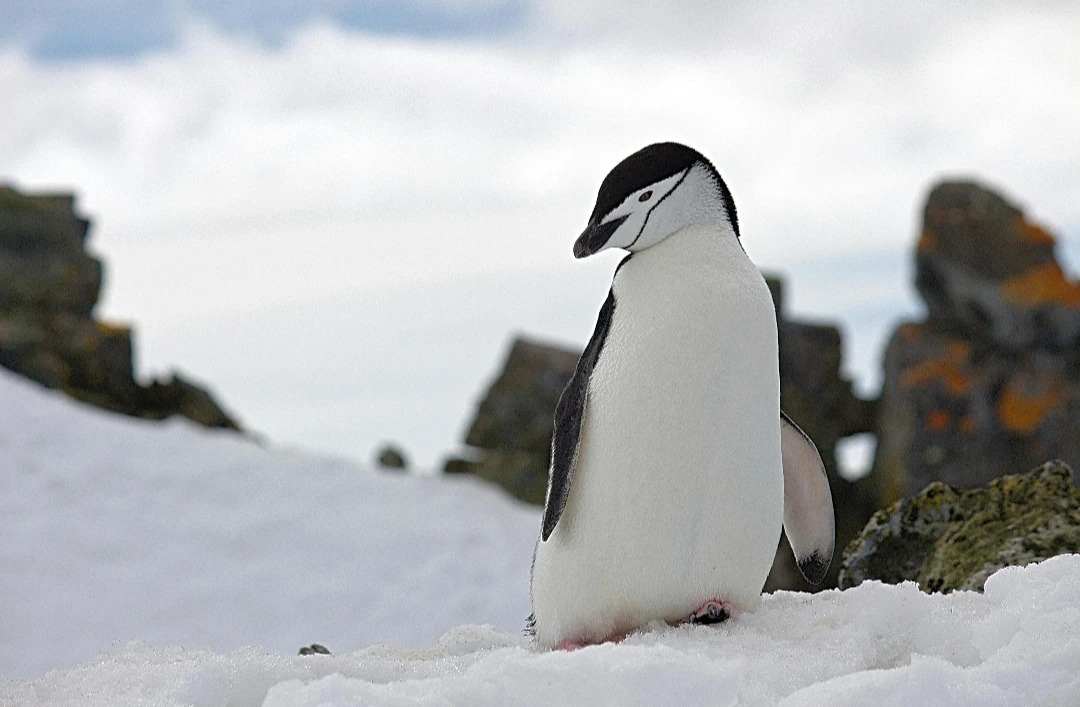
Chinstrap penguins, easily identified by the distinctive black band running under their chins, are iconic inhabitants of the Antarctic region. These small, resilient birds thrive on the islands and coastlines of the Southern Ocean, forming large, noisy colonies amidst harsh environmental conditions.
With their feisty demeanour and impressive adaptability, chinstrap penguins embody the resilience necessary for survival in one of the planet’s most extreme environments. Their life cycle—from challenging breeding seasons to extensive foraging journeys—offers valuable insights into the dynamics of Antarctic ecosystems.
Appearance
Chinstrap penguins stand about 68 cm (27 inches) tall and weigh up to 5 kg (11 lbs), making them one of the smaller penguin species found in Antarctica. Their narrow black band under the chin contrasts sharply with their otherwise white faces, lending them a unique appearance among Antarctic birds. Chinstrap penguins possess sleek, streamlined bodies, perfectly suited for their aquatic lifestyle, enabling them to move efficiently both in and out of water.
These physical traits not only distinguish chinstraps visually but also contribute to their exceptional swimming capabilities, which are vital for their survival in the Southern Ocean’s challenging conditions.
Behaviour
Highly social creatures, chinstrap penguins gather in large colonies, sometimes numbering in the hundreds of thousands. Within these crowded nesting sites, they communicate through loud, harsh calls, creating a cacophony that resonates across the landscape. Known for their spirited and even aggressive nature, chinstraps navigate both land and sea with agility and resilience.
In water, chinstrap penguins are swift swimmers, reaching speeds up to 30 km/h (18.6 mph). Their ability to dive and manoeuvre in pursuit of prey makes them formidable hunters, illustrating their adaptability to the Antarctic environment.
Diet
The diet of chinstrap penguins primarily consists of krill, supplemented by small fish and other crustaceans. Their foraging habits are closely tied to the seasonal availability of krill, requiring extensive travel during the breeding season to locate abundant feeding grounds. Some chinstrap penguins journey hundreds of kilometres to find food, demonstrating their endurance and adaptability.
The dependence of chinstraps on krill links them to the health of the broader Antarctic marine ecosystem. Variations in krill populations, often influenced by environmental changes, directly affect chinstrap populations, making them vital indicators of ecosystem health.
Reproductive Cycle
The breeding season for chinstrap penguins begins in November, as they return to their natal colonies to find mates and build nests from stones. Female chinstraps typically lay two eggs, and both parents share incubation duties, taking turns until the eggs hatch after approximately 35 days. Once the chicks hatch, they are fed by regurgitation until they are strong enough to fledge and make their way to the sea.
Chinstrap penguins’ fidelity to their breeding sites and partners showcases their structured social dynamics. This regular, coordinated breeding behaviour reflects their adaptation to the demands of Antarctic life, ensuring that chicks are born when food sources are relatively plentiful.
Habitat
Chinstrap penguins exhibit a circumpolar distribution, primarily inhabiting the islands of the Scotia Arc, the Antarctic Peninsula, and nearby sub-Antarctic islands. Preferring rocky, ice-free areas for nesting, they often select locations with easy sea access, allowing them to forage efficiently.
Their habitat choices, closely tied to coastal areas, offer scientists opportunities to monitor the impacts of climate change on penguin populations. As sea ice and krill availability fluctuate with warming temperatures, studying chinstraps helps in understanding broader ecological shifts in Antarctica.
Ecological Role
Chinstrap penguins’ presence in Antarctica underscores the resilience required to survive in extreme conditions. Their ability to adapt to the windswept, icy landscapes of the Southern Ocean highlights the necessity of ongoing conservation efforts to protect these remarkable birds and their habitat. As indicators of Antarctic ecosystem health, chinstrap penguins provide researchers with valuable data on the impacts of climate change and human activity on polar biodiversity.
Through studying chinstrap penguins, scientists gain a deeper understanding of the interconnectedness of Earth’s ecosystems and the critical importance of preserving the natural world. These birds are not only resilient survivors but also symbols of the intricate balance required to maintain life in some of the planet’s harshest regions.
Back To Top
King Penguin (Aptenodytes patagonicus)
The king penguin, with its stately plumage and tall stature, is one of the most captivating penguin species inhabiting the sub-Antarctic islands and the fringes of Antarctica. Second in size only to the emperor penguin, these birds are marvels of adaptation, thriving in the cold climates of the Southern Ocean.
Their remarkable diving ability and complex social structures make them key contributors to the biological diversity and ecological balance of their habitats. The presence of king penguins provides valuable insights into the health of the marine environment, as their population trends reflect broader ecological changes.
Appearance
King penguins are distinctive for their tall stature, reaching up to 95 cm (37 inches) and weighing between 11 and 16 kg (24 to 35 lbs). Their unique plumage features deep silvery-grey backs, vivid orange patches on the sides of their heads, and a bright orange-yellow chest, creating a striking contrast against their white bellies. Juvenile king penguins, in contrast, wear a thick, woolly brown coat that helps insulate them until they moult into their sleek adult plumage.
These physical characteristics make king penguins highly recognisable and contribute to their ability to withstand the sub-Antarctic climate, showcasing their specialised adaptations for life in cold environments.
Behaviour
King penguins are social animals, forming large, dense colonies on the sub-Antarctic islands. These gatherings become especially lively during the breeding season, with penguins engaging in various vocal and physical displays. Known for their endurance, king penguins are capable of fasting for weeks as they incubate their eggs and care for young chicks.
In water, king penguins are remarkable divers, reaching depths exceeding 300 meters (984 feet) to hunt. Their diving skills and physical endurance are essential for survival, allowing them to exploit deep-sea food resources unavailable to other predators.
Diet
The diet of king penguins consists mainly of small fish, including lanternfish, along with squid. They undertake long, extended foraging trips lasting several weeks, during which they may travel hundreds of kilometres to find nutrient-rich feeding grounds. This capability for extended foraging journeys enables king penguins to sustain themselves and their young, even in environments where food availability fluctuates seasonally.
Their role as top predators in the Southern Ocean provides scientists with critical data on the health of marine ecosystems. Changes in fish populations or distribution, often driven by climate change, can have significant impacts on king penguin colonies, making them reliable indicators of ecosystem stability.
Reproductive Cycle
King penguins are unique among penguin species due to their prolonged breeding cycle, which lasts more than a year and precludes annual breeding. The courtship process involves intricate visual and auditory displays, establishing strong bonds between mates. Each female lays a single egg, which is then carefully incubated on the feet of both parents, covered by a specialised fold of skin known as a brood patch.
Once hatched, the chick remains in the colony for over a year, relying on both parents for protection and food. This extended care period highlights the commitment of king penguins to their offspring and showcases their complex social and family dynamics.
Habitat
King penguins primarily inhabit the cooler sub-Antarctic islands and occasionally reach the northern stretches of Antarctica. They establish colonies on beaches and valley floors that are free of ice, selecting locations that offer easy access to the sea and are relatively sheltered from extreme weather conditions.
This habitat choice, close to productive foraging areas, reflects their need for reliable access to food. King penguins’ geographic range and habitat preferences offer scientists valuable opportunities to observe how environmental changes affect penguin populations and their surrounding ecosystems.
Ecological Role
The study and conservation of king penguins are vital for maintaining the ecological balance of their habitats. These majestic birds contribute significantly to the biodiversity of the Southern Ocean and act as barometers for the health of the marine environment. Changes in their population numbers or distribution patterns often signal shifts in ocean health, which can have cascading effects on other marine life.
As we learn more about the lives of king penguins, we are reminded of the resilience of life in the face of extreme conditions and the need for dedicated conservation efforts to protect these ecosystems. The survival of king penguins in the sub-Antarctic not only enriches our understanding of Antarctic biodiversity but also underscores the interconnectedness of Earth’s ecosystems and the pressing need to preserve our natural world.
Back To Top
Emperor Penguin (Aptenodytes forsteri)
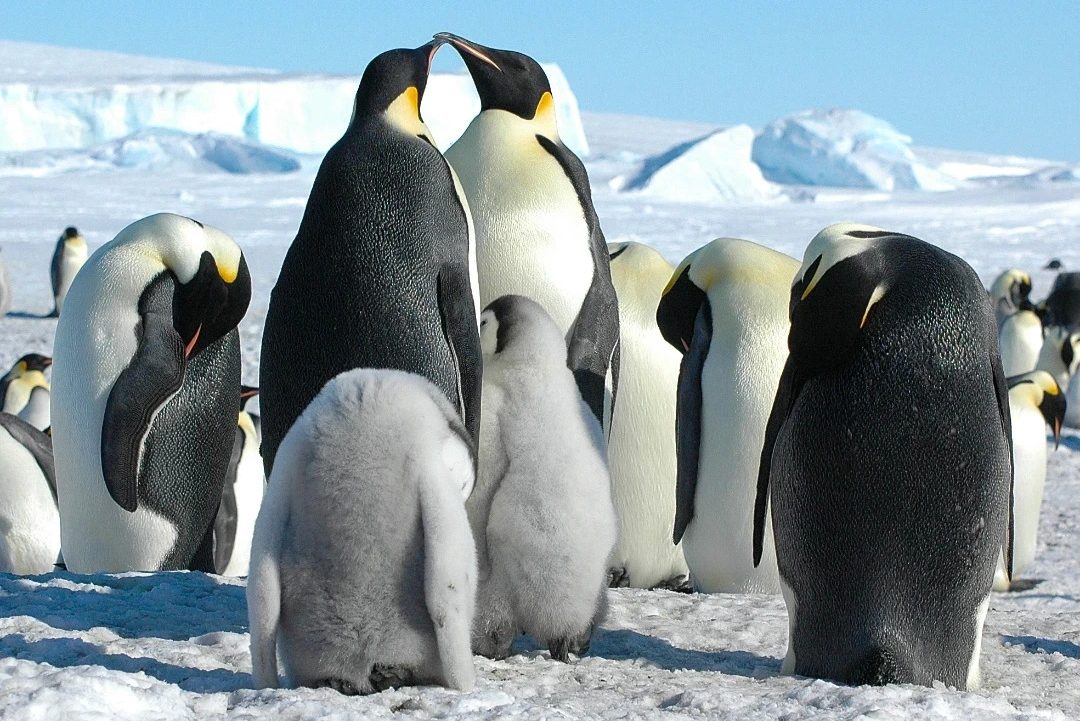
The emperor penguin, the largest and one of the most iconic penguin species, represents the pinnacle of endurance and commitment in the icy expanse of Antarctica. These majestic birds endure some of the Earth’s harshest conditions to breed, hatch, and raise their young in the continent’s interior.
With their remarkable adaptations to extreme cold and complex social behaviours, emperor penguins undertake a unique reproductive journey marked by fasting, dedicated incubation, and relentless care in the depths of the Antarctic winter. Their resilience captivates the imagination of scientists and nature enthusiasts alike.
Appearance
Emperor penguins stand up to 122 cm (48 inches) tall and weigh between 22 to 45 kg (49 to 99 lbs), making them the largest penguin species. Their distinctive black and white plumage, complemented by vibrant yellow and orange markings around their necks, distinguishes them visually. Emperor penguins’ robust bodies are optimised for minimising heat loss, an essential adaptation for surviving the relentless Antarctic cold.
These physical attributes not only contribute to their visual appeal but also enable them to withstand extreme temperatures, showcasing their remarkable adaptation to one of the planet’s most demanding environments.
Behaviour
Emperor penguins exhibit extraordinary social behaviours, especially their unique huddling strategy for warmth during brutal winters. To conserve heat, they form tight groups, constantly shifting positions to ensure each penguin has a turn in the warmer, central area of the huddle. This cooperative behaviour is vital for survival, particularly during long periods of fasting while incubating their eggs.
In the water, emperor penguins are agile and efficient hunters, capable of diving to depths over 500 meters (1,640 feet) and holding their breath for more than 20 minutes. Their grace and skill in the ocean highlight their adaptability to both land and sea, making them formidable predators despite their awkward movement on land.
Diet
The emperor penguin’s diet primarily consists of fish, with crustaceans and cephalopods like squid supplementing their intake. Their efficient hunting abilities are especially crucial in the lead-up to and during the breeding season, as they must build up fat reserves to sustain extended fasting periods.
The need to accumulate sufficient reserves showcases the penguins’ deep connection to their environment. Any changes in fish populations or prey availability due to climate shifts directly affect emperor penguin survival, making them significant indicators of ecosystem health in the Antarctic.
Reproductive Cycle
The emperor penguin’s breeding cycle is timed to coincide with the Antarctic winter, making it one of the most remarkable reproductive strategies in the animal kingdom. Both males and females trek up to 120 km (75 miles) over the ice to reach their breeding colonies. After laying a single egg, the female carefully transfers it to the male, who balances it on his feet and covers it with a feathered flap for insulation.
The female then returns to the ocean to feed, leaving the male to endure a two-month fast, during which he protects the egg through the frigid winter. This period of parental sacrifice and commitment highlights the emperor penguins’ dedication and survival instincts, underscoring their adaptability to the Antarctic’s harsh conditions.
Habitat
Emperor penguins are exclusive to Antarctica, relying on stable pack ice for breeding. They establish colonies far from open water at the onset of winter, choosing sites with thick, stable ice that offers some protection from wind and predators. The stability and location of these breeding sites are critical to their survival, as shifting sea ice due to climate change poses significant risks to their reproductive success.
Their habitat preferences, closely tied to specific ice conditions, make emperor penguins highly sensitive to environmental changes. Studying their response to fluctuating ice patterns provides crucial information about the impacts of global warming on Antarctic ecosystems.
Ecological Role
The emperor penguin’s life cycle and challenges from climate-induced changes in sea ice highlight the urgent need for conservation efforts. These birds are not only symbols of resilience but also essential barometers of Antarctic environmental health. The stability of their populations offers insight into the broader impacts of climate change on polar ecosystems, making their protection vital for preserving Antarctic biodiversity.
As we deepen our understanding of emperor penguins, we gain insight into the resilience of nature and the importance of safeguarding fragile environments. The survival of emperor penguins in the unforgiving Antarctic reminds us of the delicate balance within ecosystems and the pressing need to preserve these remarkable creatures and their habitats.
Back To Top
Magellanic Penguins (Spheniscus magellanicus)
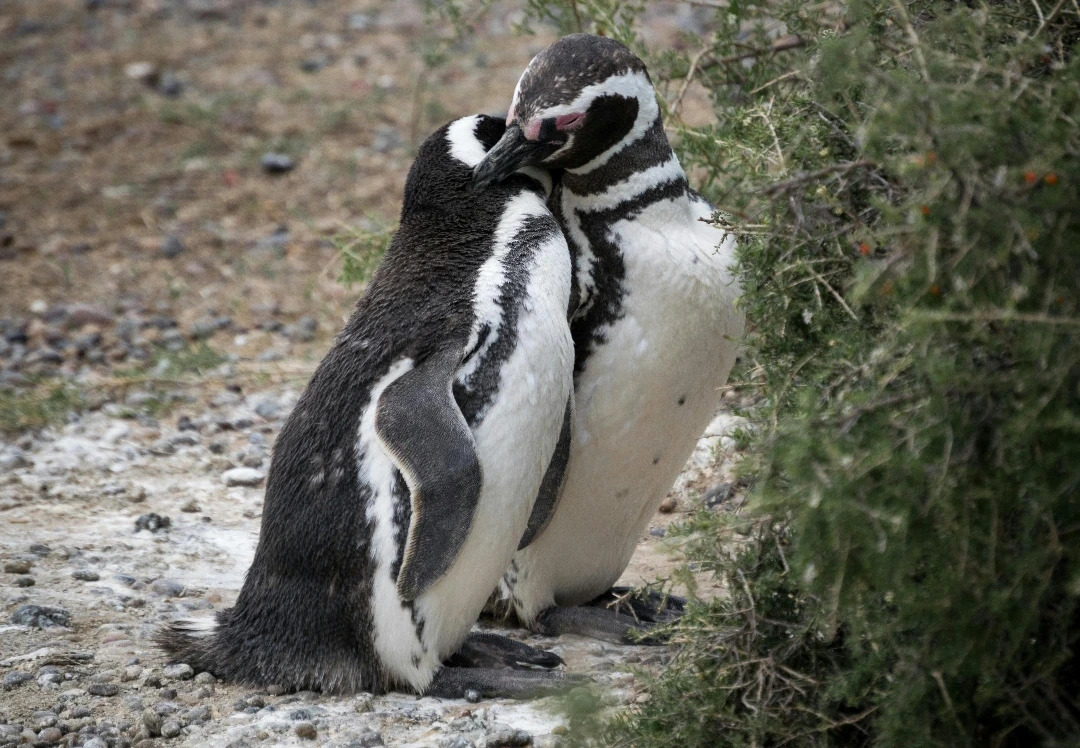
The Magellanic penguin, named after the explorer Ferdinand Magellan who first recorded sighting them in the 16th century, epitomises resilience and adaptability. These penguins inhabit the colder, challenging shores of southern South America and the Falkland Islands, where their distinctive black and white bands and unique braying call set them apart.
As they navigate between land and sea, Magellanic penguins play a critical role in their ecosystem, supporting marine health through their feeding habits. Observing these penguins offers insight into the balance of coastal ecosystems and underscores the importance of protecting these habitats from the increasing pressures of climate change and human activity.
Appearance
Magellanic penguins are medium-sized, standing 60 to 75 cm (24 to 30 inches) tall and weighing between 2.7 to 6.5 kg (6 to 14 lbs). Their black backs and white abdomens are accentuated by two prominent black bands between the head and chest, and a white band looping from the eye down the neck. Their webbed feet and streamlined bodies enhance their swimming capabilities, allowing them to move adeptly through coastal waters.
These physical traits not only distinguish Magellanic penguins visually but also make them well-suited to the dual demands of life on land and at sea, showcasing their adaptations to their unique habitat.
Behaviour
Magellanic penguins are sociable creatures, forming large colonies that may consist of thousands of breeding pairs. These penguins are monogamous, with many pairs reuniting each breeding season. They use their distinctive vocalisations to locate one another, strengthening their bonds each year. On land, they adeptly navigate rocky terrain to reach nesting sites, and in the water, they are proficient swimmers, using their flippers to propel themselves as they search for food.
The social structure of Magellanic penguins reflects their adaptability and highlights the importance of strong pair bonds and cooperative parenting in ensuring survival in challenging environments.
Diet
The diet of Magellanic penguins consists primarily of small fish, squid, and krill. Skilled hunters, they dive to depths of up to 100 meters (330 feet) but typically forage closer to the surface where prey is abundant. Their feeding patterns are closely aligned with the seasonal availability of prey, which influences both their migration routes and breeding timing.
Their role in the food web, along with their reliance on healthy fish populations, underscores their importance as indicators of marine ecosystem health. Any changes in prey availability due to climate shifts or overfishing directly impact Magellanic penguin populations, making them vital for understanding broader ecological dynamics.
Reproductive Cycle
The breeding season for Magellanic penguins begins in September, when they return to their natal colonies to nest. They either burrow into the ground or use natural depressions to create secure nesting sites. Females generally lay two eggs per season, and both parents share incubation duties and chick-rearing responsibilities. The chicks fledge after approximately 11 weeks, during which they are dependent on their parents for warmth and nourishment.
This shared parental role demonstrates the collaborative nature of Magellanic penguin parenting, showcasing a level of familial dedication necessary for raising offspring in the often unpredictable coastal environment.
Habitat
Magellanic penguins are primarily found along the southern coasts of South America, from Brazil to Chile, and on the Falkland Islands. They favour sandy or pebbly beaches for their colonies, ensuring easy access to the sea for foraging. During the non-breeding season, they migrate northwards in search of warmer waters, often reaching as far as Brazil.
Their migratory patterns, driven by seasonal shifts in temperature and food availability, make them highly sensitive to changes in oceanic conditions. As such, Magellanic penguins provide valuable insights into the effects of climate variability on migratory species.
Ecological Role
The conservation of Magellanic penguins is vital for preserving the biodiversity of their coastal and marine environments. These penguins act as indicators of ocean health, reflecting the impacts of climate change and human activities on marine ecosystems. Understanding the life cycles and behaviours of Magellanic penguins is essential for developing conservation strategies that protect their habitats and support their continued survival in their southern range.
Magellanic penguins remind us of the intricate balance within marine ecosystems and the importance of protecting migratory species from the escalating pressures of environmental change. By safeguarding their habitats, we not only ensure the survival of these resilient birds but also contribute to the broader health of marine ecosystems along the southern coasts of South America.
Back To Top
Macaroni Penguin (Eudyptes chrysolophus)
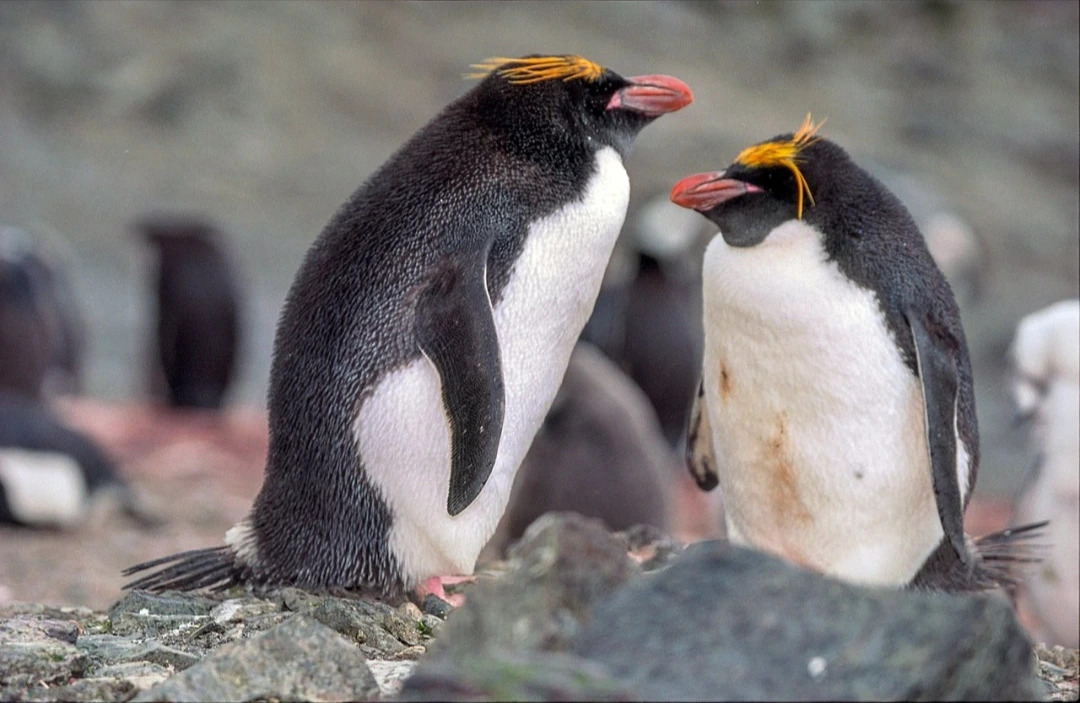
The macaroni penguin, distinguished by its flamboyant yellow-orange crest and lively disposition, is one of the most recognisable penguin species inhabiting the sub-Antarctic regions and parts of the Antarctic Peninsula.
Named after an 18th-century fashion trend rather than pasta, these striking birds embody the rugged beauty and energetic essence of their icy habitats. The macaroni penguin’s life, marked by extensive foraging journeys and densely populated breeding colonies, reflects the challenging conditions of the Southern Ocean.
As crucial players in the Antarctic food web, macaroni penguins contribute significantly to marine ecosystem stability and provide valuable insights into the impacts of climate change on polar ecosystems.
Appearance
Magellanic penguins are medium-sized, standing 60 to 75 cm (24 to 30 inches) tall and weighing between 2.7 to 6.5 kg (6 to 14 lbs). Their black backs and white abdomens are accentuated by two prominent black bands between the head and chest, and a white band looping from the eye down the neck. Their webbed feet and streamlined bodies enhance their swimming capabilities, allowing them to move adeptly through coastal waters.
These physical traits not only distinguish Magellanic penguins visually but also make them well-suited to the dual demands of life on land and at sea, showcasing their adaptations to their unique habitat.
Behaviour
Magellanic penguins are sociable creatures, forming large colonies that may consist of thousands of breeding pairs. These penguins are monogamous, with many pairs reuniting each breeding season. They use their distinctive vocalisations to locate one another, strengthening their bonds each year. On land, they adeptly navigate rocky terrain to reach nesting sites, and in the water, they are proficient swimmers, using their flippers to propel themselves as they search for food.
The social structure of Magellanic penguins reflects their adaptability and highlights the importance of strong pair bonds and cooperative parenting in ensuring survival in challenging environments.
Diet
The diet of Magellanic penguins consists primarily of small fish, squid, and krill. Skilled hunters, they dive to depths of up to 100 meters (330 feet) but typically forage closer to the surface where prey is abundant. Their feeding patterns are closely aligned with the seasonal availability of prey, which influences both their migration routes and breeding timing.
Their role in the food web, along with their reliance on healthy fish populations, underscores their importance as indicators of marine ecosystem health. Any changes in prey availability due to climate shifts or overfishing directly impact Magellanic penguin populations, making them vital for understanding broader ecological dynamics.
Reproductive Cycle
Macaroni penguins begin their breeding season in October or November, returning to their colonies to mate. They often reunite with the same partner, a behaviour that reinforces pair bonds and stability within the colony. The birds construct nests from stones and vegetation, with each female typically laying two eggs. However, usually only one chick survives to fledging, as parents focus their energy on nurturing a single offspring.
Both parents share responsibilities in incubation and chick-rearing, alternating between foraging trips and care duties. This collaborative parenting strategy enables macaroni penguins to raise chicks successfully in a demanding environment, where food must be consistently sourced from distant foraging grounds.
Habitat
Macaroni penguins are widespread throughout the sub-Antarctic and parts of the Antarctic Peninsula. They favour rocky, tussock-grass-covered areas for their large breeding colonies. During the non-breeding season, macaroni penguins spend the majority of their time at sea, covering extensive areas of the Southern Ocean in search of food.
Their habitat preference for specific coastal regions enables scientists to monitor the impact of environmental changes on macaroni populations. Their seasonal movement patterns and reliance on marine resources make them excellent indicators of oceanic health and ecosystem stability.
Ecological Role
The conservation of macaroni penguins is essential for preserving the health of Antarctic and sub-Antarctic ecosystems. These birds, with their vibrant appearance and survival strategies tailored to extreme conditions, highlight the interconnected nature of marine life. As their populations face pressures from climate change and human activities, macaroni penguins serve as barometers for the impacts on the broader marine environment.
Studying macaroni penguins allows scientists to understand the complex relationships within polar ecosystems and reinforces the need for international conservation efforts. Protecting macaroni penguins and their habitats is crucial for ensuring the long-term stability of these remarkable birds and the dynamic ecosystems they inhabit, safeguarding biodiversity in one of the planet’s most unique regions.
Back To Top
Rockhopper Penguin (Eudyptes chrysocome)
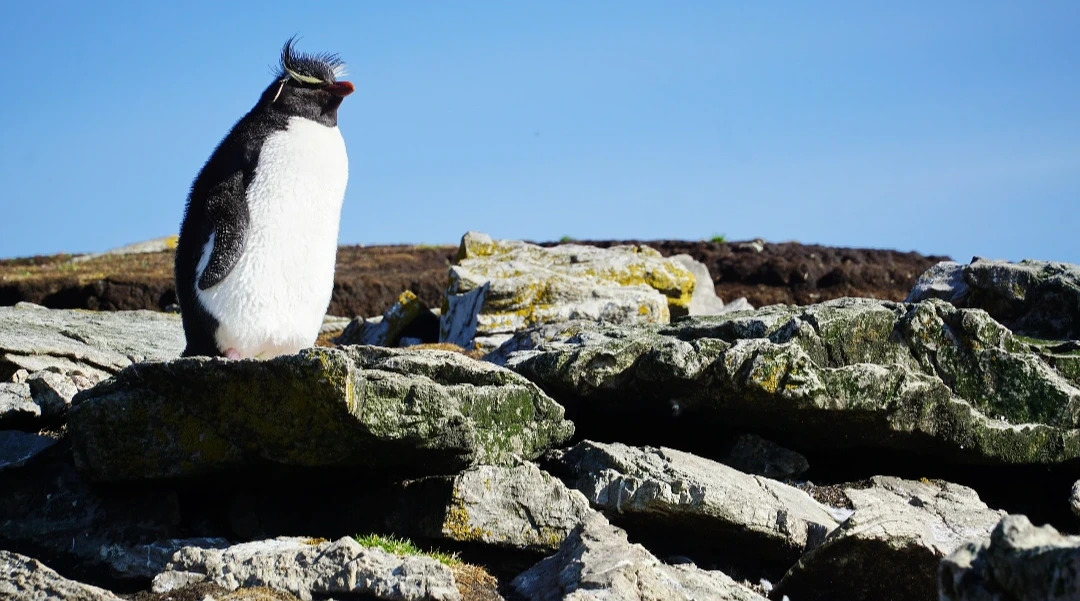
The rockhopper penguin, with its spiky yellow-black crest feathers and striking red eyes, embodies the spirit of resilience and adventure in the sub-Antarctic region. Unlike other penguins that waddle, rockhoppers are named for their distinctive ability to hop over rocks and boulders, allowing them to traverse rocky shorelines with ease.
Found along some of the world’s most turbulent seas, these small yet bold penguins captivate observers with their unique appearance and fearless personalities. However, as environmental changes threaten their populations, the conservation of rockhopper penguins has become increasingly critical, underscoring the importance of protecting the balance of Southern Hemisphere marine ecosystems.
Appearance
Rockhopper penguins are among the smaller penguin species, standing about 50 to 58 cm (20 to 23 inches) tall and weighing between 2 and 3.5 kg (4.4 to 7.7 lbs). Their distinctive spiky feathers, extending as bold yellow and black crests from the tops of their heads, set them apart visually from other penguins. Their intense red eyes and short orange bills enhance their striking appearance, while their predominantly black and white plumage offers camouflage in both the ocean and their rocky nesting grounds.
These physical traits not only give rockhopper penguins a unique look but also aid in their social interactions and adaptation to rugged coastal habitats.
Behaviour
Renowned for their feisty and assertive nature, especially during breeding, rockhopper penguins are highly social animals. They gather in large, noisy colonies on steep, rocky coastlines where their agility allows them to navigate rough terrain effectively. This social and aggressive demeanour is essential for competing for nesting sites and mates within dense colonies.
In the water, rockhopper penguins are powerful swimmers, using their flippers to propel themselves swiftly in pursuit of prey. Their swimming prowess and adaptability on land enable them to thrive in environments where other species might struggle.
Diet
The diet of rockhopper penguins includes krill, squid, and small fish. Skilled divers, they typically forage near the ocean surface but can dive up to 100 meters (328 feet) when necessary. During foraging trips, which may extend several kilometres from shore, they spend most of their time at sea outside the breeding season.
Their position as mid-level predators links rockhopper penguins closely to the health of marine ecosystems. Changes in prey availability, influenced by overfishing and climate change, directly impact their survival and serve as indicators of broader oceanic health.
Reproductive Cycle
The breeding season for rockhopper penguins begins in late spring. Upon returning to their colonies, they pair up and build nests from pebbles, grass, and other materials found on the rocky terrain. Nesting in crevices and under boulders offers their eggs protection from predators and the elements. Typically, females lay two eggs, though usually only one chick survives to fledging. Both parents share duties in incubating the eggs and feeding the chicks.
This cooperative breeding behaviour, combined with their sturdy nesting strategies, enables rockhopper penguins to raise young in challenging conditions, highlighting their adaptability to life in exposed coastal environments.
Habitat
Rockhopper penguins are widely distributed across several sub-Antarctic islands and parts of the Antarctic Peninsula, favouring rugged coastlines and rocky beaches for their colonies. There are two subspecies: the Eastern and Western rockhopper penguins, each occupying distinct areas within the sub-Antarctic region.
Their habitat choice along isolated, rocky coastlines provides scientists with opportunities to study the impacts of environmental changes on these adaptable birds. The division between Eastern and Western subspecies also allows researchers to monitor how different regions of the Southern Ocean respond to climate variability.
Ecological Role
The conservation of rockhopper penguins is crucial as their populations face declines due to climate change, overfishing, and habitat destruction. As adaptable mid-level predators, rockhoppers play a vital role in maintaining the balance of marine ecosystems. Their declining numbers signal the need for action to protect the dynamic environments of the Southern Ocean.
Studying rockhopper penguins provides insights into the resilience of species in extreme environments and reinforces the importance of safeguarding marine ecosystems. As we deepen our understanding of these charismatic penguins, we are reminded of the shared responsibility to protect the natural world and the remarkable creatures that inhabit it.
Conservation efforts aimed at preserving rockhopper penguins and their habitats are essential for ensuring the health of marine ecosystems across the Southern Hemisphere.
Further reading
The British Antarctic Survey has some good informaton about penguins.
Back To Top







